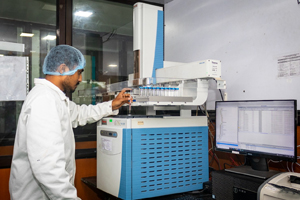Our Facilities
To be the world’s most trusted partner for Quality Assurance.

Thermo ICP-MS Triple quadrupole instrument have helped to take the analysis of trace elements to a new level, delivering better interference removal and significantly improved detection limits for key analytes.
The instrument has analytical capability with complete trace elemental analysis and technique to determine low-concentrations (range: ppb = parts per billion = µg/l) and ultra-low-concentrations of elements (range: ptt = parts per trillion = ng/l).
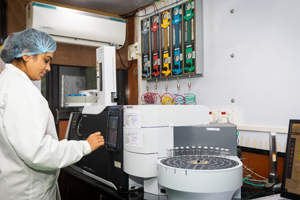
Make: Shimadzu
The Gas Chromatography/Mass Spectrometry (GC/MS) instrument separates chemical mixtures (the GC component) and identifies the components at a molecular level (the MS component). … The GC works on the principle that a mixture will separate into individual substances when heated.
The triple quadrupole mass spectrometer allows for increased sensitivity and specificity yielding lower detection and quantitation limits. For these reasons, employment of the TQMS is a vital asset in the fields of drug metabolism, pharmacokinetics, environmental studies, and biological analyses. In most drug and pharmacokinetic studies, animals like rats, are subjected to a new drug in order to probe how the substance metabolizes in the body. By analysing the rat’s urine or plasma with a triple quadrupole coupled to liquid chromatography, the concentration and fragmentation pattern of the new drug can be determined. In environmental and biological studies, the triple quadrupole is useful for quantitative studies that involved identifying whether or not specific substances are present in a sample. One of the more common uses of a triple quadrupole mass analyzer is for structural elucidation,
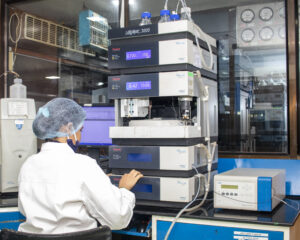
High Performance Liquid Chromatography (HPLC) is a technique in analytical chemistry used to separates identity and quantify each component in a mixture.
We have HPLC (Auto sampler) instrument from Agilent and Thermofisher with the variety of detectors.
We routinely carry out the following analysis on HPLC
- Pharmaceutical raw and finish products
- Quantification of vitamins
- Impurity profiling of pharmaceuticals
- Estimation of Aflatoxins
- Method development
- Method validation
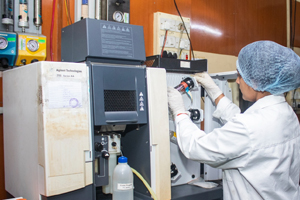
AAS is a Spectro analytical procedure for the quantitative determination of chemical elements using the absorption of optical elements and radiation by force atoms in the gaseous state.
This technique is widely used technique for trace analysis of elements in matrices ranging from foods, waste waters, geological, Pharmaceutical and biological.
We are equipped with the state of art Agilent Technology 200 atomic absorption spectrophotometer which provides convient analysis in the ppm level for major constituents. The typical samples analysed are feed, food, water, metals, decay.
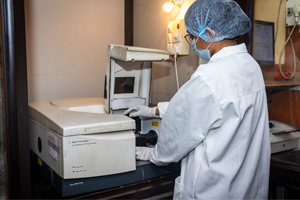
FTIR (Fourier Transform Infra-Red Spectroscopy) is a sensitive technique particularly for identifying organic chemicals in a whole range of applications although it can also characterise some inorganics. Examples include paints, adhesives, resins, polymers, coatings and drugs. It is a particularly useful tool in isolating and characterising organic contamination.
Gas chromatography (GC) is a common type of chromatography used in analytical chemistry for separating and analysing compounds that can be vaporized without decomposition. Typical uses of GC include testing the purity of a particular substance, or separating the different components of a mixture. GCHS is used for Analysis of all type of residual solvent.
We have Gas Chromatography Mass Spectrometry from Agilent and Thermofisher with the variety of detectors.
- FLAME IONIZATION DETECTOR (FID)
- THERMAL CONDUCTIVITY DETECTOR (TCD)
- ELECTRON CAPTURE DETECTOR (ECD)
Ion chromatography system for analysis of anions like fluoride, chloride, nitrate, phosphate and sulphate by conductivity detection and cations like lithium, sodium, potassium and calcium by conductivity detection. The system should be able to perform both suppressed and non-suppressed conductivity applications.
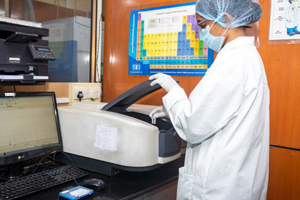
UV spectroscopy is type of absorption spectroscopy in which light of ultra-violet region (200-400 nm.) is absorbed by the molecule. Absorption of the ultra-violet radiations results in the excitation of the electrons from the ground state to higher energy state
The energy of the ultra-violet radiation that are absorbed is equal to the energy difference between the ground state and higher energy states (deltaE = hf).
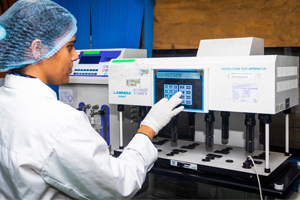
Routinely used in pharmaceutical industry for drug development and quality control, dissolution testing is widely accepted method to understand the bioavailability of dosage forms (tablets and capsules) which, is important to understand the rate at which the tablet or capsule dissolves in the gastrointestinal tract, and releases the drug substance in the body. This bioavailability measurement process is precisely achieved by Dissolution Test Apparatus or Dissolution Tester. This instrument simulates the environment of the human gastrointestinal tract.
To test the disintegration capability of tablets and capsules as per the pharmacopoeial standards like USP, BP, and IP.
If for instance the disintegration time within the set of samples varies or is too high or low then it wouldn’t correspond to the pharmacopeial standards.
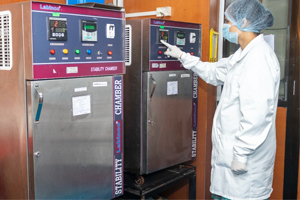
JPCLPL Offers stability storage and testing services for food, pharmaceuticals & cosmetic products.
Dedicated storage facilities include.
- Real Time Stability
- Accelerated Stability
Elisa Reader is a commonly used analytical biochemistry assay,
ELISA is a rapid test used for detecting or quantifying antibodies (Ab) against viruses, bacteria, and other materials or antigens (Ag).
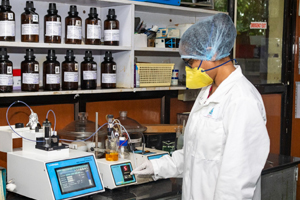
pH and conductivity Meter
Potentiometer
COD Digestor
Refractometer
Flash point Apparatus

